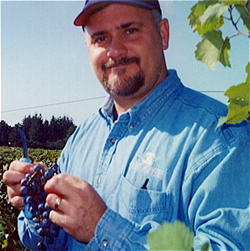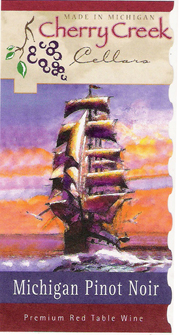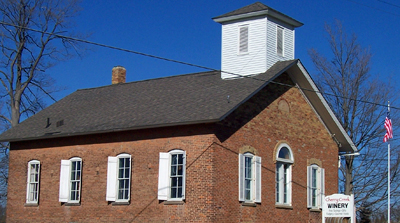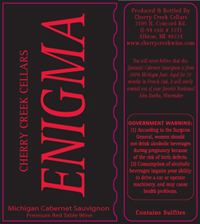

Cherry Creek Cellars owner/winemaker John Burtka makes a wide variety of vinfera wines and, yes, even ones from Michigan cherries.
Cherry Creek Cellars Sees
Green in Its Red Wines
Although the name Cherry Creek Cellars seemingly stresses cherries, a celebrated Michigan fruit, it belies the red wine passion, production and winery focus that is moving this winery forward.
by
Eleanor & Ray Heald
April 15, 2008
Eleanor & Ray Heald (ERH): Why did you choose a location outside one of Michigan’s AVAs to open your winery?
John Burtka (JB): We chose Parma Township in the Jackson, Mich., area because that’s where we live. Additionally, we’re convinced that vinifera varieties can be grown here.
ERH: Who or what were the influences to start a Michigan winery?
JB: As a kid, I made wine with my father, who had made wine for personal use with my grandfather. Actually, it goes back generations. I then started with my family and entered a state amateur competition. I won best of show two years in a row.
ERH:: Do you own your own vineyards or do you source your grapes?
JB: Both
ERH:: How many acres of estate vineyard and what varieties?
JB: We have 1,500 vines at the Parma winery location, dedicated to Pinot Noir (Clone 777 on 3309 rootstock) and Vidal Blanc. The soil is sandy loam but where we’ve planted Pinot Noir, it’s quite rocky.
and Vidal Blanc. The soil is sandy loam but where we’ve planted Pinot Noir, it’s quite rocky.
ERH: What are the viticultural advantages of the vineyard?
JB: A south-facing slope with sufficient rocks for excellent drainage. In August, Pinot Noir is at 16 or 17 degrees Brix, so we get outstanding ripening.
ERH: What are the vineyard challenges?
JB: We can get late mid-May frost. That happened in 2007. Winter kill over the last few years has wiped out about 25 percent of the vineyard and we will be filling in missing plants this Spring. Other challenges are birds (which decimated all the Pinot Noir in 2007), deer and Japanese beetles.
ERH: What training/trellising system is employed?
JB: A permanent quadrilateral cordon and vertical shoot position (VSP) trellis.
ERH: From whom do you source grapes?
JB: Lemon Creek vineyard in the Lake Michigan Shore AVA. We purchase Cabernet Sauvignon, Gewurztraminer, Pinot Grigio and Chardonnay.
ERH: Many growers claim that Cabernet Sauvignon does not get sufficiently ripe in Michigan. Yet, you’ve had success. Why?
JB: The trick with Cabernet Sauvignon in Michigan is good tannin balance, achieved by
Cherry Creek Cellars’ tasting room is situated in an historic old schoolhouse building.letting fruit hang until November. It costs in yield but with a long hang time, Michigan Cabernet Sauvignon becomes more fruit forward than much from California. It also has a great finish perceived on the back palate.
ERH: Can you reveal some economic statistics for Cherry Creek?
JB: Under our own label, we produce 2,000 cases. That rises to 3,000 cases when we include the wine we make for other people. We’ve experienced a 30 percent increase in sales in each of the last three years.
ERH: What are new varietal wines that you are releasing in 2008?
JB: Dry Gewürztraminer, unoaked Chardonnay, 2006 Pinot Noir, 2006 Montage (a blend of 75 percent Cabernet Sauvignon and 25 percent Chancellor), 2006 Cabernet Sauvignon (proprietarily named Enigima and 100 percent varietal) and 2007 Cabernet Sauvignon dry Rosé.
ERH: Since you do make a sweet Rosé, what prompted you to make a dry style too?
JB: A summer trip to Provence.
ERH: How is the Cabernet Sauvignon Rosé made?
JB: We crush 25 percent of the fruit prior to fermentation and use the free run juice for the Rosé. The skins from this crushing are added back to the other 75 percent and the process for varietal Cabernet Sauvignon continues traditionally.
ERH: What else is on the horizon?
JB: We have a tasting room location in a former schoolhouse in Michigan’s Irish Hills area. We purchased an additional 10 acres there and we will plant a portion to Cabernet Franc in May. In Parma, we’ll also continue to plant red varieties principally.
Because we need to expand the winemaking area, by Summer, we’ll move our entire winemaking operations to the schoolhouse location, on U.S. Highway 12 and three miles west of the Michigan International Speedway (MIS), which seats over 137,000 motor sports fans.
A growing segment of our customers are 20- and 30-somethings. To continue to attract that age group, we’re combining the Parma winemaking area with the existing tasting room to create one large tasting room in an upbeat, eclectic design. A blackened ceiling will have theater-type lighting. The tasting bar with a white marble top will have a cobalt blue front. Techno-type music will be played in the background and we will schedule after-hours events.
A blackened ceiling will have theater-type lighting. The tasting bar with a white marble top will have a cobalt blue front. Techno-type music will be played in the background and we will schedule after-hours events.
We plan to add a restaurant at the schoolhouse location and turn both properties into destinations. We need a wine and food destination in the central part of the state. The Pioneer Wine Trail has been successful but there’s a lot more that we can develop – and for red wine lovers!
ERH: Maybe NASCAR motor sports fans too. Far fetched? Not so fast on that judgment. Former race car driver Randy Lynch is now owner of Napa Valley’s Bennett Lane Winery with his wife Lisa. He loves red wines and makes them.
OK, that’s Napa Valley but we believe that Michigan’s Irish Hills region with its rolling landscape holds serious potential for vinifera red grapes.
Get a taste of Cherry Creek wines. Read The Heald’s reviews at APPELLATION AMERICA.
Photos courtesy of Cherry Creek Cellars
John Burtka (JB): We chose Parma Township in the Jackson, Mich., area because that’s where we live. Additionally, we’re convinced that vinifera varieties can be grown here.
ERH: Who or what were the influences to start a Michigan winery?
JB: As a kid, I made wine with my father, who had made wine for personal use with my grandfather. Actually, it goes back generations. I then started with my family and entered a state amateur competition. I won best of show two years in a row.
ERH:: Do you own your own vineyards or do you source your grapes?
JB: Both
ERH:: How many acres of estate vineyard and what varieties?
JB: We have 1,500 vines at the Parma winery location, dedicated to Pinot Noir (Clone 777 on 3309 rootstock)
 and Vidal Blanc. The soil is sandy loam but where we’ve planted Pinot Noir, it’s quite rocky.
and Vidal Blanc. The soil is sandy loam but where we’ve planted Pinot Noir, it’s quite rocky.
ERH: What are the viticultural advantages of the vineyard?
JB: A south-facing slope with sufficient rocks for excellent drainage. In August, Pinot Noir is at 16 or 17 degrees Brix, so we get outstanding ripening.
ERH: What are the vineyard challenges?
JB: We can get late mid-May frost. That happened in 2007. Winter kill over the last few years has wiped out about 25 percent of the vineyard and we will be filling in missing plants this Spring. Other challenges are birds (which decimated all the Pinot Noir in 2007), deer and Japanese beetles.
ERH: What training/trellising system is employed?
JB: A permanent quadrilateral cordon and vertical shoot position (VSP) trellis.
ERH: From whom do you source grapes?
JB: Lemon Creek vineyard in the Lake Michigan Shore AVA. We purchase Cabernet Sauvignon, Gewurztraminer, Pinot Grigio and Chardonnay.
ERH: Many growers claim that Cabernet Sauvignon does not get sufficiently ripe in Michigan. Yet, you’ve had success. Why?
JB: The trick with Cabernet Sauvignon in Michigan is good tannin balance, achieved by

Cherry Creek Cellars’ tasting room is situated in an historic old schoolhouse building.
ERH: Can you reveal some economic statistics for Cherry Creek?
JB: Under our own label, we produce 2,000 cases. That rises to 3,000 cases when we include the wine we make for other people. We’ve experienced a 30 percent increase in sales in each of the last three years.
ERH: What are new varietal wines that you are releasing in 2008?
JB: Dry Gewürztraminer, unoaked Chardonnay, 2006 Pinot Noir, 2006 Montage (a blend of 75 percent Cabernet Sauvignon and 25 percent Chancellor), 2006 Cabernet Sauvignon (proprietarily named Enigima and 100 percent varietal) and 2007 Cabernet Sauvignon dry Rosé.
ERH: Since you do make a sweet Rosé, what prompted you to make a dry style too?
JB: A summer trip to Provence.
ERH: How is the Cabernet Sauvignon Rosé made?
JB: We crush 25 percent of the fruit prior to fermentation and use the free run juice for the Rosé. The skins from this crushing are added back to the other 75 percent and the process for varietal Cabernet Sauvignon continues traditionally.
ERH: What else is on the horizon?
JB: We have a tasting room location in a former schoolhouse in Michigan’s Irish Hills area. We purchased an additional 10 acres there and we will plant a portion to Cabernet Franc in May. In Parma, we’ll also continue to plant red varieties principally.
Because we need to expand the winemaking area, by Summer, we’ll move our entire winemaking operations to the schoolhouse location, on U.S. Highway 12 and three miles west of the Michigan International Speedway (MIS), which seats over 137,000 motor sports fans.
A growing segment of our customers are 20- and 30-somethings. To continue to attract that age group, we’re combining the Parma winemaking area with the existing tasting room to create one large tasting room in an upbeat, eclectic design.
 A blackened ceiling will have theater-type lighting. The tasting bar with a white marble top will have a cobalt blue front. Techno-type music will be played in the background and we will schedule after-hours events.
A blackened ceiling will have theater-type lighting. The tasting bar with a white marble top will have a cobalt blue front. Techno-type music will be played in the background and we will schedule after-hours events.
We plan to add a restaurant at the schoolhouse location and turn both properties into destinations. We need a wine and food destination in the central part of the state. The Pioneer Wine Trail has been successful but there’s a lot more that we can develop – and for red wine lovers!
ERH: Maybe NASCAR motor sports fans too. Far fetched? Not so fast on that judgment. Former race car driver Randy Lynch is now owner of Napa Valley’s Bennett Lane Winery with his wife Lisa. He loves red wines and makes them.
OK, that’s Napa Valley but we believe that Michigan’s Irish Hills region with its rolling landscape holds serious potential for vinifera red grapes.
Photos courtesy of Cherry Creek Cellars










 READER FEEDBACK: To post your comments on this story,
READER FEEDBACK: To post your comments on this story,



